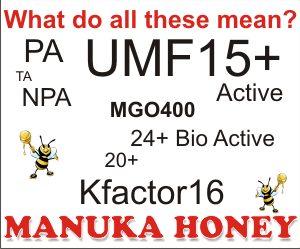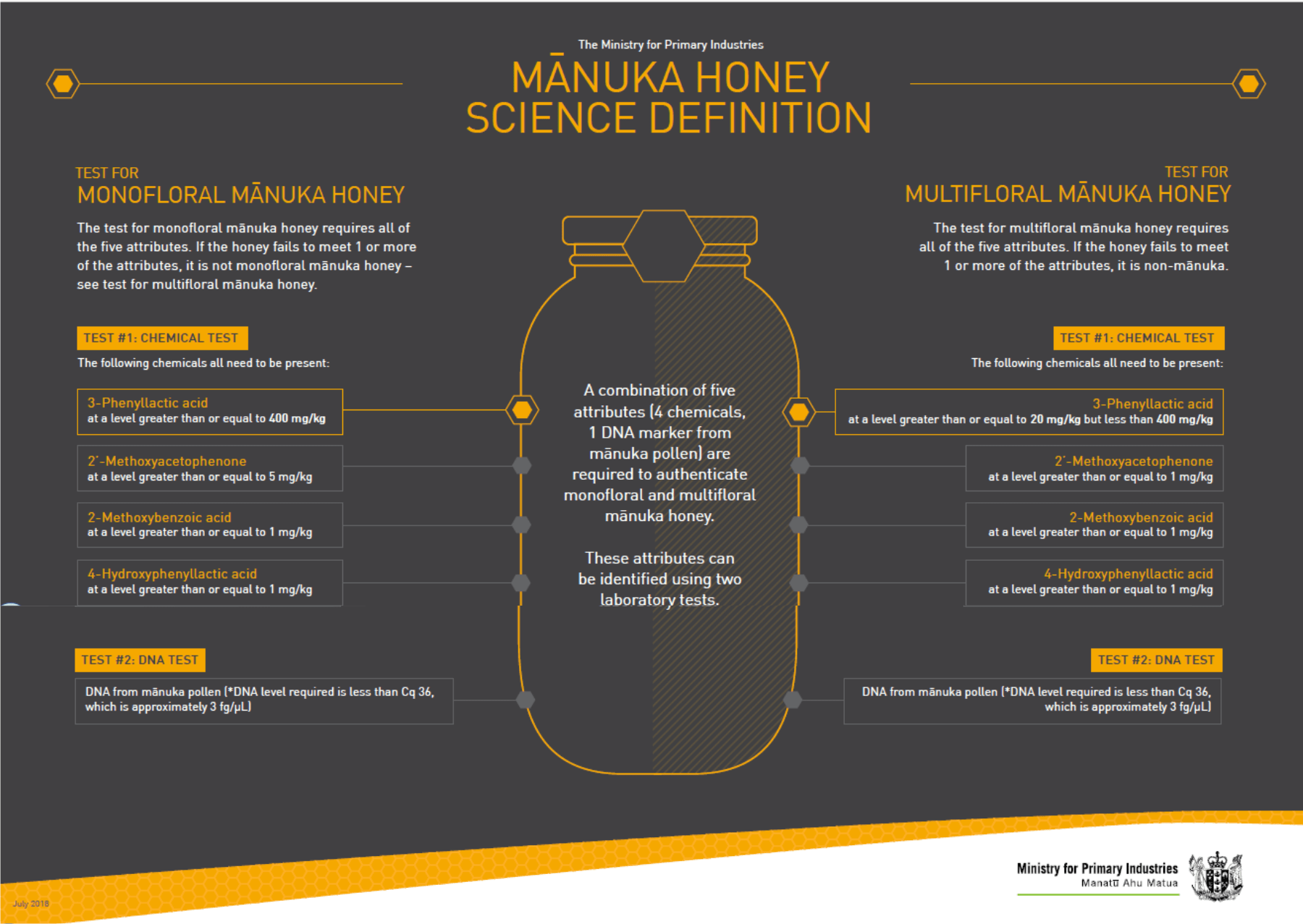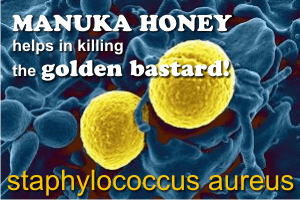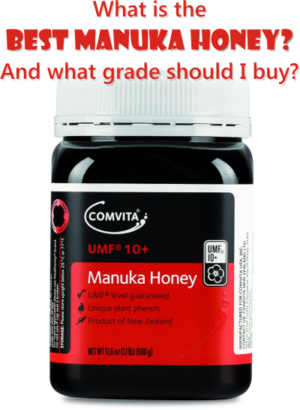The true markers of genuine New Zealand Manuka honey have been recently issued by Nz’s government and they are different than the ones currently used. We need to be sure the producer complies with the new regulations.
Somebody told me the other day that manuka honey was real if it had MGO (methylglyoxal). This is false. Not all manuka honey contains MGO. MGO is not a marker of manuka honey, it is a marker of therapeutic manuka honey.
But before we find out what manuka honey is good for a certain treatment, we need to make sure we have genuine manuka honey. Meaning that it really comes from the nectar of Leptospermum scoparium flowers and, from New Zealand.
Of course this was also a measure imposed by New Zealand in order to protect its exclusivity in selling their liquid gold, manuka honey.
So, in order to be sure that a certain batch of honey is NZ manuka honey or not, several tests need to be done. Then, to establish its therapeutic grade, other tests are done.
Until recently there were several markers that were used to define and identify genuine New Zealand manuka honey. But due to increasing frauds other markers have been searched. The goal was to identify manuka honey from NZ, even if the honey is genuine and good but comes from other countries (like Australia).
They say the real manuka honey, the one that has been researched and studied and has real therapeutic value is only the New Zealand manuka honey.
Genuine New Zealand Manuka Honey Markers
When it comes to manuka honey which will be exported, the New Zealand Government has issued a science definition for it. They did that to eliminate frauds as much as possible, to maintain the high standard of this type of honey and, of course, to differentiate it from manuka honey produced in other countries.
Something wrong in this picture?
Yes, I had the same feeling. What is this, multifloral manuka honey?
I live in Europe and I never saw a jar of multifloral manuka honey. They are all manuka honey. The explanation is given by the Ministry of the Primary Industries: ” the label can only state that the honey is manuka honey (without other qualification, like monofloral) if the honey meets MPI’s definition for monofloral manuka honey.
Multifloral manuka honey means that that the honey bees stuck their tongues in other flowers too, not only in manuka. The majority remains, of course, but that batch of honey cannot be called pure manuka anymore. Its medical value will decrease according to its amount of MGO, HMF, leptosperin etc.
The label can use the words “multifloral manuka”, “manuka blend” or other words that imply that the honey
is made from more than one honey type including manuka, if the honey meets MPI’s definition for multifloral manuka honey.
 Every exported manuka honey must comply with the labeling requirements of the importing country. If the producers has the name “manuka” in its trademark, sells manuka honey, but the honey does not meet MPI’s definition, it must specify on the label that that specific honey is not manuka honey. They can use the work manuka when mentioning the floral source.
Every exported manuka honey must comply with the labeling requirements of the importing country. If the producers has the name “manuka” in its trademark, sells manuka honey, but the honey does not meet MPI’s definition, it must specify on the label that that specific honey is not manuka honey. They can use the work manuka when mentioning the floral source.
Another thing wrong in the picture: where is leptosperin? Or lepteridine?
• A research team from Comvita (a well-known producer of NZ manuka honey) conducted by Jessie Bong (recipient of the Claude Stratford Research Scholarship, at The University of Auckland) and Head of Honey Research, Comvita, Dr. Jonathan Stephens, did a research, undertaken over a three-year period and described how unique signature compounds can be identified and used to profile genuine Manuka honey.
According to the Comvita research, the most significant signature compounds of Manuka honey were found to be leptosperin, lepteridine and 2-methoxyacetophenone (all nectar-derived). And though the use of leptosperin in a Manuka definition has gained widespread support from the industry, this marker was not included in the definition proposed by the Ministry for Primary Industries. (Probably because this marker is also found in Australian manuka honey and the a specific NZ attribute had to be something found, in a specific amount, only in NZ.)
Comvita CEO Scott Coulter said, “We would like to see leptosperin in MPI’s Manuka honey definition, recognising both the scientific justification, and the strong industry alignment around this key compound. As science continues to advance the understanding of Manuka honey, the definition needs to advance with it.”
• A study from 2017, conducted by Jessie Bong et al., also showed that leptosperin, lepteridine, 2-methoxyacetophenone, and 2-methoxybenzoic acid are exclusive to manuka nectar.
3-Phenyllactic acid and 4-hydroxyphenyllactic acid are present in manuka nectar but can also be found in kanuka nectar (a cousin of manuka). Leptosperin, lepteridine, 3-phenyllactic acid, and 4-hydroxyphenyllactic acid are chemically stable over prolonged storage at 37°C.
The researchers established an optimal concentration cut-off for manuka honey: leptosperin (94 mg/kg), lepteridine (2.1 mg/kg), 20-methoxyacetophenone (2.0 mg/kg).
Their conclusion?
Leptosperin and lepteridine are definitive fluorescence markers for authentication of manuka honey.
Here is the Criteria for identifying mānuka honey, a summary of the mānuka honey science programme, started in 2014 and issued in 2017, that led to the 5 attributes of manuka honey.
Genuine Manuka Honey markers:
According to the new science definition, Genuine Manuka Honey from New Zealand requires 5 attributes that are measured using 2 laboratory tests: 1 chemical and 1 for DNA.
If the honey fails to meet 1 or more of the attributes, it is not monofloral mānuka honey, or multifloral mānuka honey accordingly.
Test #1:
The following chemicals all need to be present:
- 3-Phenyllactic acid – at a level greater than or equal to 400 mg/kg. (in multifloral manuka honey: at a level greater than or equal to 20 mg/kg but less than 400 mg/kg)
3-Phenyllactic acid (PLA) is a broad spectrum antimicrobial compound, active against bacteria and fungi. It is present in honey in higher amounts than other phenolic acids. PLA is also preset in thistle unifloral honey (around 100 – 800 mg/kg) and in higher concentrations in heather (820 mg/kg), ling heather (875 mg/kg) and manuka honeys (243 mg/kg).
Anti-staphylococcal activity against methicillin resistant Staphylococcus aureus was reported in manuka honey which contained high levels of acetic and lactic acids. (Mannina L et al., 2016) Here is a detailed review on this acid.
- 2’-Methoxyacetophenone – at a level greater than or equal to 5 mg/kg. (in multifloral manuka honey: at a level greater than or equal to 1 mg/kg)
- 2-Methoxybenzoic acid – at a level greater than or equal to 1 mg/kg.
- 4-Hydroxyphenyllactic acid – at a level greater than or equal to 1 mg/kg
Test #2:
- DNA from manuka pollen – DNA level required is less than Cq 36, which is approximately 3 fg/µL. This test confirms that there is sufficient pollen from the Manuka bush in the honey for it to be regarded as Manuka honey. DNA from pollen in the honey is extracted and analysed to confirm the presence of manuka pollen.
Where are the tests done?
There are 2 laboratories in NZ that have been certified to carry out these 2 tests, Analytica Laboratories and Hill Laboratories. The two tests are likely to cost around $100 per test. They offer a wide range of tests, including for Dihydroxyacetone (DHA), Methylglyoxal (MGO), and Hydroxymethylfurfural (HMF). They also test for the presence of tutin toxin, pesticide residue, c4 sugar adulteration and others.
In the UK the 2 tests can be done here: fera.co.uk.
Domestic NZ manuka honey is not the same with exported NZ manuka honey.
Have you recently visited New Zealand and bought a lot of manuka honey, because it was cheaper? Well, you might not have what you expected. The manuka honey sold inside the New Zealand is not the same with the one sold worldwide. The local producers should not do all these tests to sell their manuka honey inside their own country. In 2018 a public consultation was hold to find out people’s opinion on whether honey sold in the domestic market should meet those strict standards, too.
You may also be interested in What is the best manuka honey? From what brand?
Make sure you buy genuine manuka honey! Check this list!
References:
https://www.mpi.govt.nz/dmsdocument/27348/loggedIn
http://www.voxy.co.nz/national/5/289341
http://www.umf.org.nz/wp-content/myimages/2017/07/Chemical-profiling-Bong-et-al.pdf
https://www.tvnz.co.nz/one-news/new-zealand/should-m-nuka-honey-standards-more-strictly-regulated-in-nz-consultation-closes-today
http://www.umf.org.nz/wp-content/myimages/2018/01/Identification-of-Ma%CC%84nuka-Honey.pdf
featured picture crop, credit Ryan Merce via flickr.com





